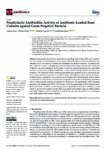Prophylactic Antibiofilm Activity of Antibiotic-Loaded Bone Cements against Gram-Negative Bacteria
Gram-negative bacilli can be responsible for prosthetic joint infection (PJI) even if staphylococci are the main involved pathogens. Gram-negative PJIs (GN-PJI) are considered difficult-to-treat
infections due to the increase in antimicrobial resistance and biofilm formation. To minimize the
risk of infection in cases of arthroplasties with cemented prosthesis, bone cement can be loaded with
antibiotics, especially gentamicin. In this study, we aimed to compare the prophylactic antibiofilm
activity of ready-to-use antibiotic-loaded bone cements (ALBC), already commercialized or new
prototypes. We compared ALBCs containing gentamicin alone, gentamicin plus vancomycin, gentamicin plus clindamycin, gentamicin plus Fosfomycin, and fosfomycin alone, to plain cement (no
antibiotic); these comparisons were conducted to investigate the biofilm formation of three strains
of Escherichia coli, three strains of Pseudomonas aeruginosa and two strains of Klebsiella pneumoniae,
with or without specific resistance to gentamicin or fosfomycin. We reported that ALBC containing
gentamicin and clindamycin (COPAL G+C) seems to be the most interesting ALBC of our tested panel
for the prevention of biofilm formation by gentamicin-susceptible strains, even if clindamycin is not
effective against Gram-negative bacteria. However, gentamicin-resistant strains are still a problem,
and further studies are needed to identify an antibiotic to associate with gentamicin for an efficient
dual ALBC against Gram-negative bacteria.



